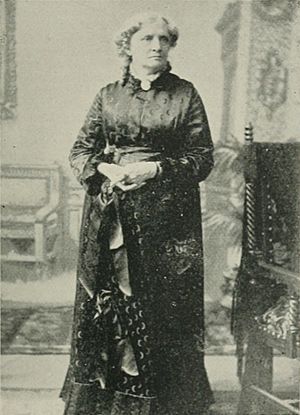Isabella Beecher Hooker facts for kids
Quick facts for kids
Isabella Beecher Hooker
|
|
|---|---|

Isabella Beecher Hooker portrait by C. M. Bell Studio
|
|
| Born |
Isabella Holmes Beecher
February 22, 1822 |
| Died | January 25, 1907 (aged 84) |
| Occupation | Suffragist |
| Spouse(s) | John Hooker |
| Children | Thomas Beecher Hooker Mary Beecher Hooker Alice Beecher Hooker Edward Beecher Hooker |
| Parent(s) | Lyman Beecher and Harriet Porter |
Isabella Beecher Hooker (February 22, 1822 – January 25, 1907) was an important leader and speaker. She was a social activist in the American movement for women's right to vote, also known as the suffragist movement.
Contents
Isabella's Early Life and Family
Isabella Holmes Beecher was born on February 22, 1822, in Litchfield, Connecticut. She was the fifth child of Reverend Lyman Beecher and Harriet Porter. Her family moved often as her father took on new church roles.
Isabella went to her half-sister Catharine Beecher's Western Female Institute in Cincinnati. This school closed during a financial crisis called the Panic of 1837. After her mother died, Isabella returned to Connecticut. At age 15, she studied at the Hartford Female Seminary. This was a school her sister Catharine had started.
Marriage and Family Life
While studying in Hartford, Isabella met John Hooker. He was a young lawyer from a well-known Connecticut family. They got married in 1841. For the next 25 years, Isabella focused on raising their three children.
John Hooker believed in ending slavery, a cause known as abolitionism. Isabella did not agree at first. But she slowly came to support the anti-slavery movement. During the 1850s, she helped the abolitionist cause. However, her main focus was being a mother. In 1853, the Hooker family moved to Hartford. They bought land that became part of the Nook Farm Literary Colony.
Isabella's Fight for Women's Rights
After the Civil War, Isabella began to get involved in the women's rights movement. She wrote a letter called "A Mother's Letter to a Daughter on Women Suffrage." In it, she shared the idea that women would make politics more moral. She believed women would bring a motherly wisdom to government.
Isabella went to women's rights meetings in New York and Boston. She helped start the New England Women Suffrage Association. She then founded the Connecticut Women Association. She also started the Society for the Study of Political Science in Hartford.
Working for Property Rights
Isabella then started a petition for the Connecticut General Assembly. With her husband's help, she wrote a bill. This bill would give married women the right to own property. The bill was rejected at first. But Isabella presented it every year until it finally passed in 1877.
By 1870, Isabella Beecher Hooker was very active in the suffragist movement. She traveled across the Midwest on her first speaking tour. This tour helped prepare for the 1871 Washington convention on suffrage. This meeting focused only on the right to vote for women. Isabella hoped this focus would bring the divided women's movement back together.
Speaking to Congress
Isabella believed the U.S. Constitution already gave women citizenship. She thought Congress just needed to recognize this fact for women to vote. This convention helped the women's movement get a hearing in Congress for the first time. Victoria Woodhull and Isabella presented their arguments to the House Judiciary Committee.
Isabella kept using this constitutional argument through the 1870s. She spoke many more times before the House Judiciary Committee. She felt it would be too hard to pass a new constitutional amendment. Most congressmen disagreed with her. They said Congress could not decide who could vote.
Isabella felt so strongly that women could already vote that she tried to vote in the 1872 election. Susan B. Anthony succeeded in voting and was arrested. However, Isabella could not get past the security at her polling place.
Later Activism and Recognition
By the mid-1880s, Isabella changed her approach. She argued that women should vote because they would bring more respect to politics. She also started campaigning for women's rights in general, not just voting rights. In 1887, she spoke about the need for women to have bigger roles in society. She even suggested having female police officers. She was made fun of by some newspapers for these ideas.
Even though some newspapers mocked her, Isabella Hooker was well-known across the country. Her speaking tours were often reported in the news. She also gained respect in Hartford. The Hartford Courant newspaper published her speeches and her addresses to Congress.
As she traveled less, she continued her work by writing letters. She also presented a voting bill to the Connecticut General Assembly every year. Her last appearance before Congress was in 1893. There, she convinced some senators to support a limited voting proposal. Isabella's last time presenting the voting bill to the General Assembly was in 1901.
Isabella's Final Years
Isabella Beecher Hooker was with her half-sister Harriet Beecher Stowe when she died in Hartford in 1896. Isabella suffered a stroke on January 13, 1907. She passed away twelve days later.
Isabella died more than ten years before the Nineteenth Amendment was passed in 1920. This amendment finally gave women the right to vote across the United States. Isabella's work helped the women's movement grow from a small group to a powerful force. In her home state of Connecticut, Isabella Hooker's main achievement was helping to pass the law giving married women property rights in 1877.
See also
 In Spanish: Isabella Beecher Hooker para niños
In Spanish: Isabella Beecher Hooker para niños


